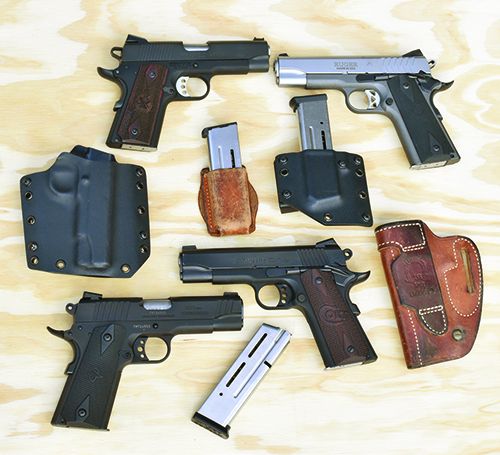Ruger SR1911The U.S. Army adopted the Colt Model 1892 New Revolver chambered in 38 Long Colt in – drum roll please – 1892. This chambering, which is roughly equivalent to a mild 148-grain wadcutter loading in 38 Special worked well until it had to be used in combat. The Spanish-American War brought American troops to the Philippines where native tribesmen took exception to their presence and tried to make them leave. We have read many stories about how the Moro tribesmen, whether on drugs or just pure adrenalin, were able to soak up multiple hits from the 38 Colt and still injure or even kill our troopers. The Army decided that something needed to be done about this and a search for a new service pistol began. The first solution was to beef up the Model 1892, allowing it to handle a modified 45 Colt cartridge (the case rim had been enlarged to make for more positive extraction). This was also the dawn of the semi-auto pistol, so the Model 1909 in 45 Colt turned out to be a stopgap measure and the search continued. Enter the brilliant firearms designer John Moses Browning with his solution to the problem. Initial prototypes were produced and tested in 1905 with a much-revised model being presented in 1910 and adopted by the Army in April of 1911, hence the current name of a Model 1911. This pistol was originally chambered for the then-new 45 ACP (Automatic Colt Pistol) cartridge, the ballistics of which, with a 230-grain bullet at 830 feet per second, closely resembled the big bullet, going slow formula that had worked for the U.S. military for 50 years. Today, using newly engineered bullets at a similar or faster velocity, the 45 ACP is still one of the best fight stoppers in the handgun world. In 1949, in an effort to standardize U.S.-service sidearms to match NATO Allies, the Army issued a request for a lighter-weight, semi-auto pistol chambered in 9mm. Firearms submitted for test included several Hi-Power variants, the Smith & Wesson Model 39, as well as a Colt 1911 version with a shorter slide and barrel mated to an aluminum frame. The Army decided to stand pat with their sidearms, but the Colt Lightweight Commander had been born and Colt began offering this to the public in 1950. When defensive-style pistol competition really came into its own in the 1970s, Colt was a primary player in the 1911 market. The Government Model pistols became the firearms of choice for several reasons: power, ergonomics, and the trigger. The 1911-style trigger, which is pressed straight to rear in compression, rather than a hinged piece describing an arc, is still today one of the easiest triggers to learn to shoot well. Well-built 1911s can frequently be found whose triggers only require 4 to 5 pounds of pressure to compress. Take up is minimal, overtravel can be tuned to where it is almost non-existent, and reset is fast. The problem with pistols designed for the military is that they are sometimes engineered with extra tolerance in the parts to allow these firearms to function in almost any situation. This slop, if you will, is great for reliability but the absolute enemy of accuracy. When one of the testers for Gun Tests began shooting USPSA (United States Practical Shooting Association) matches in 1984, common practice was to buy a Colt Government Model 1911, save the slide and frame, toss most of the other parts, and then take the remaining parts along with all the new ones to a gunsmith. Another $1,000 later (in 1984 dollars) and you had a shooter. The year of 2020 is a different world for those who desire a great 1911. Industry knowledge of the platform has matured greatly, along with the understanding of what works and what doesn’t. CNC machines now let gunmakers do quickly and precisely, via machine, what used to require many hours of highly-skilled hand labor. Accordingly, when we set out to review some of the latest generation of 9mm 1911s, we found completed pistols, containing many of the modifications we used to pay big bucks for, already included on the base pistols, all for less money than we used to pay for just the parts. Because of its shorter cartridge length and several other reasons, the 9mm version was always one of the trickier calibers to make work in a 1911. But, because there are several real advantages using this cartridge in this platform (recoil, magazine capacity, spring weights, etc.), we tested four different 9mm 1911 pistols for you. Which ones worked? Which worked quickly? Were they accurate? Let’s find out.
9MM LUGER RANGE DATA
All shooting was done at American Shooting Centers in west Houston (AmShootCenters.com). We chronographed each load with a LabRadar device and shot each for groups at 15 yards from a well-sandbagged Caldwell Pistol Rest.| Black Hills 9mm 100-gr. HoneyBadger | Taurus 1911 CDR | Colt LW CDR | Ruger SR1911 | Springfield Range Officer |
| Average Velocity | 1191 fps | 1226 fps | 1174 fps | 1209 fps |
| Muzzle Energy | 315 ft.-lbs. | 334 ft.-lbs. | 306 ft.-lbs. | 325 ft.-lbs. |
| Average Group | 5.97 in. | 1.98 in. | 1.39 in. | 1.90 in. |
| Hornady 115-gr. Critical Def | Taurus 1911 CDR | Colt LW CDR | Ruger SR1911 | Springfield Range Officer |
| Average Velocity | 1109 fps | 1117 fps | 1079 fps | 1112 fps |
| Muzzle Energy | 314 ft.-lbs. | 319 ft.-lbs. | 298 ft.-lbs. | 316 ft.-lbs. |
| Average Group | 2.51 in. | 2.17 in. | 1.87 in. | 2.48 in. |
| Speer 124-gr. Gold Dot +P | Taurus 1911 CDR | Colt LW CDR | Ruger SR1911 | Springfield Range Officer |
| Average Velocity | 1221 fps | 1207 fps | 1197 fps | 1201 fps |
| Muzzle Energy | 410 ft.-lbs. | 401 ft.-lbs. | 395 ft.-lbs. | 397 ft.-lbs. |
| Average Group | 2.83 in. | 2.59 in. | 1.97 in. | 2.40 in. |
Our 9mm 1911s came in slightly different configurations: the Taurus 1911 Commander (1-191101COM-9MM, $470), a Colt Lightweight Commander (04842XE, $895), the Ruger SR1911 LW Commander Stainless (06722, $775), and the Springfield Armory 1911 Range Officer LW Compact (P19125L, $730). All used barrels 4 to 4.25 inches long and some type of steel slide. Three of the pistols used alloy frames and one had a steel frame. Three of those frames were full length and one had a shorter “Officer’s Model” length grip. We had two different types of feed ramps and three different geometries on the barrels. And only one favorite. The original Colt 1911, as designed by John Moses Browning, was a superb handgun, well suited for self-defense in almost any environment. It served our armed forces well for 73 years as our official sidearm and is still carried by many Special Forces operators, though in a more than slightly different configuration. When Practical Shooting competitions were forming in the 1970s, theoretically equal emphasis was placed on accuracy, speed, and power. With the rules so defined, 1911s became the pistol to use. But they were never designed to run reliably at the speeds required by competition, so the modifications began. Shooters would take their Colts or Springfield Armory 1911s with a bag of parts to their gunsmith and say “Fix it, please.” Requested modifications often included:
- Lowered ejection port, with the rear relieved a bit to aid in ejection and protect empty brass.
- Higher-visibility sights, whether of the fixed variety or, even more commonly, a quality adjustable set.
- A solid bushing fitted to the barrel.
- A barrel and link fitted to the slide and frame for function and accuracy.
- High-ride beavertail grip safety to allow the hand to ride up higher on the grip safety, thus protecting the hand and lowering felt recoil.
- Rounded, Commander-style hammer.
- Skeletonized trigger with over-travel screw to allow for lighter trigger compression and less overall movement.
- Beveled or flared mag well for faster magazine changes.
- Checkered mainspring housing and/or frontstrap.
- Oversized thumb safety.
- Polished feed ramp and throat on the barrels.
The 1980s cost could easily be into the four-figure range, plus the pistol. Today’s Taurus 1911 Commander 9mm comes from the factory with all of the above and does it at a street price we have seen at less than $500!
How We Tested
All shooting was done at American Shooting Centers in west Houston (AmShootCenters.com). We chronographed each load with a LabRadar device and shot each for groups at 15 yards from a well-sandbagged Caldwell Pistol Rest, using multiple types of practice and defensive ammunition. We used a SIG Tacops Government Model (5-inch barrel), as well as a SIG Ultra Compact (3-inch barrel) both in 45 ACP to give us comparison energy figures. We did speed and accuracy drills at targets ranging from 5 to 30 yards distant. We used Remington green box 124-grain FMJ for break in and function testing. Then we shot several hundred rounds of Black Hills 100-grain Honey Badger, Hornady 115-grain Critical Defense, and Speer 124-grain Gold Dot +P to see how these four 1911s worked with defensive ammunition. Here’s what we found: Test #1: First five shots from low ready, USPSA target, 7 yards.
Test #2: Draw from a concealment holster. Fire 5 shots into a 5-inch circle at 5 yards.
Test #3: Failure to stop drill. Two shots to lower A zone; one shot to upper A zone. From low ready, 7 yards.
| DRILL #1 Data | |||
| Pistol | Time to First Shot (seconds) | Split Average (seconds) | Total Time (seconds) |
| Taurus 1911 Commander | 1.14 | 0.208 | 1.97 |
| Springfield RO Compact | 0.97 | 0.223 | 1.86 |
| Ruger SR1911 | 0.73 | 0.193 | 1.5 |
| Colt LW Commander | 0.95 | 0.22 | 1.76 |
| DRILL #2 Data (5x5x5) | |||
| Pistol | Time to First Shot (seconds) | Split Average (seconds) | Total Time (seconds) |
| Taurus 1911 Commander | 0.93 | 0.253 | 1.95 |
| Springfield RO Compact | 0.91 | 0.285 | 2.05 |
| Ruger SR1911 | 0.99 | 0.2 | 1.79 |
| Colt LW Commander | 0.88 | 0.208 | 1.71 |
| Drill #3 DATA | |||
| Pistol | Time to First Shot (seconds) | Split Average (seconds) | Total Time (seconds) |
| Taurus 1911 Commander | 0.97 | 0.315 | 1.6 |
| Springfield RO Compact | 0.81 | 0.32 | 1.45 |
| Ruger SR1911 | 0.87 | 0.345 | 1.56 |
| Colt LW Commander | 0.8 | 0.275 | 1.35 |
Taurus 1911 Commander 1-191101COM-9MM 9mm Luger, $470
GUN TESTS GRADE: B-
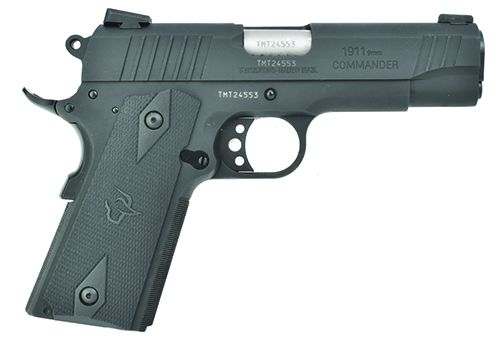
| Action Type | Semi auto, hammer fired, single action only |
| Overall Length | 7.8 in. |
| Overall Height | 5.5 in. |
| Maximum Width | 1.4 in. |
| Weight Unloaded | 35.8 oz. |
| Weight Loaded | 42.6 oz. w/10 rounds 124-gr. Hornady JHP |
| Slide Material | Carbon steel |
| Slide Retraction Effort | 18.9 oz. |
| Receiver Material | Carbon steel |
| Finish | Monochromatic black |
| Front Strap Height | 2.3 in. |
| Back Strap Height | 3.2 in. |
| Barrel Length | 4.25 in. |
| Grip Thickness (Maximum) | 1.2 in. |
| Grip Circumference | 5.4 in. |
| Magazine | Two 9-round |
| Rear Sight | Novak 2-dot in dovetail, windage adjustable, set screw |
| Front Sight | 1-dot in dovetail, set screw |
| Sight Radius | 5.6 in. |
| Trigger Pull Weight | 7.2 lbs. |
| Trigger Span | 2.6 in. |
| Safety | Firing pin drop, manual thumb safety, grip safety |
| Warranty | Limited lifetime |
| Telephone | (305) 624-1115 |
| Website | TaurusUSA.com |
| Made In | Brazil |
The Taurus 1911 Commander is finished in a simple, matte black with contrasting controls. The hammer, grip safety, thumb safety, slide release and magazine catch are all a polished black. Grips are of a checkered diamond pattern, made of polymer and attached with hex head screws. The barrel seems to be well fitted to the slide with no movement evident when the barrel hood is depressed. Both the front strap and mainspring housing are fine checkered in a pattern that is well executed though not particularly sharp. The magazine well is slightly beveled to aid in insertion. Both front and rear sights are black with white dots, mounted in dovetails and anchored by set screws. Wide, angled cocking serrations are present at the front and rear of the slide. The barrel is thicker than some we have seen, and the pistol uses a full-length recoil spring guide rod. Takedown is via normal procedure: Verify that the pistol is unloaded, check it again, use a bushing wrench to rotate the bushing clockwise, remove the recoil spring, rotate the bushing back all the way counter-clockwise and remove the bushing, line the slots up on the side of the slide and remove the slide release from right side to left, take off the slide and push out the barrel. The Commander is packed in a substantial case with two 9-round Mec-Gar magazines. Ten-rounders are readily available as aftermarket parts. The Taurus is an all-steel firearm, in contrast to the other three pistols in this test, each of which has an alloy frame mated to a steel slide. That makes the Taurus heavier than our other samples, which should, theoretically, result in lighter felt recoil. We did not feel that was the case and wonder if the recoil-spring weight could have been a factor. The Taurus had the heaviest slide retraction effort and was noticeably harder to cycle the slide by hand. Recoil springs are required to operate the pistol and must be of at least a minimum weight or the pistol does not cycle. Heavier recoil springs help ensure function of a pistol to a point. Past that point, reliability can suffer and felt recoil increases because of the slide’s mass moving back and forth under increased spring pressure. The ejection pattern put the empty brass just to our right side and slightly forward — another indication of a heavy recoil spring. Recoil springs are also cheap, available almost everywhere and, perhaps, the easiest thing on a 1911 to replace. 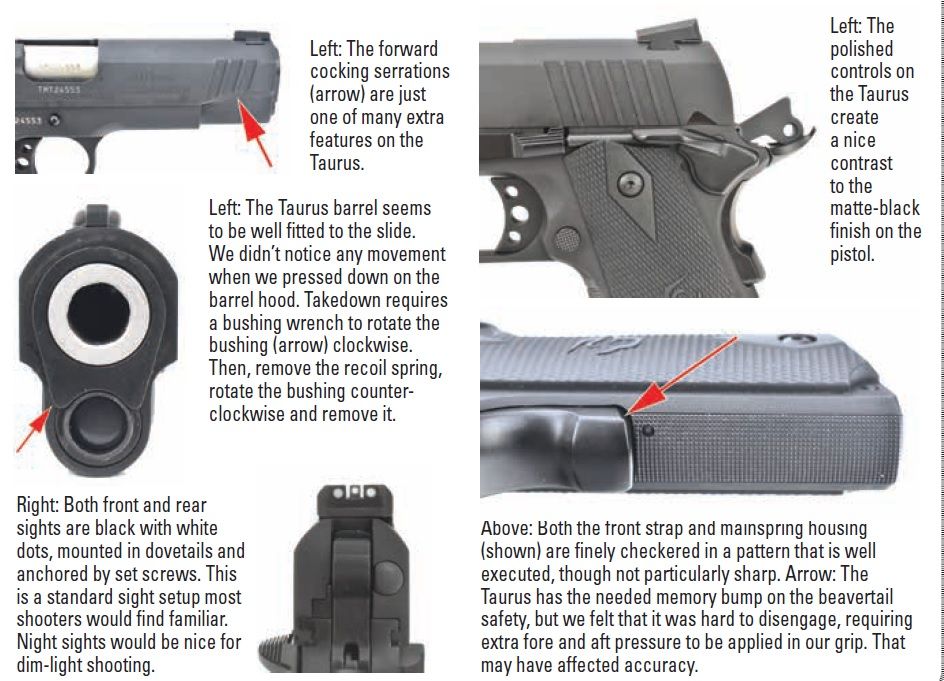 The basic 1911 design presents a superb fighting or target pistol that is slim for concealment’s sake, shoots an adequate to excellent cartridge for a pistol, and does so with the most “shootable” trigger on the market. Trigger compression can be light, crisp, and in a line straight to the rear. This same outstanding trigger can also create a couple of potential issues for the 1911 owner. First, the light, short movement aspect of the trigger virtually mandates a manual safety. This is provided on all 1911’s as a hinged lever, immediately forward of the hammer in a position easily activated by the right thumb. Ambidextrous models (with levers on both sides) are commonly available. Proper technique for the 1911 requires that the strong side thumb “live” on the safety whenever the pistol is on the hand. The only time the thumb is removed from the safety is to raise the lever into the safe position or manipulate the pistol, for example, to perform a reload or clear a malfunction. Second is the grip safety, which is a lever that has to be compressed on the back of the grip. If both safeties are not depressed simultaneously, a correctly functioning 1911 does not fire. This can be an issue for those with smaller or less-than-beefy hands. With the hand positioned high enough to properly disengage the thumb safety, the palm may not be able to correctly depress the grip safety and the pistol will not fire. The most commonly used cure for this has been to use a grip safety with a “memory pad” or extra-thick bump on the bottom of the grip safety. The palm engages this safety earlier in the gripping process, pushes the grip safety farther forward allowing the tab on the grip safety to raise earlier and the gun to fire when needed. The Taurus has the needed memory bump, but we felt that it was hard to disengage, requiring extra fore and aft pressure to be applied in our grip and, possibly, contributing to some of the large groups we witnessed from this pistol. Once again, this is an easy fix, but it is one that should be done by a competent gunsmith.
The basic 1911 design presents a superb fighting or target pistol that is slim for concealment’s sake, shoots an adequate to excellent cartridge for a pistol, and does so with the most “shootable” trigger on the market. Trigger compression can be light, crisp, and in a line straight to the rear. This same outstanding trigger can also create a couple of potential issues for the 1911 owner. First, the light, short movement aspect of the trigger virtually mandates a manual safety. This is provided on all 1911’s as a hinged lever, immediately forward of the hammer in a position easily activated by the right thumb. Ambidextrous models (with levers on both sides) are commonly available. Proper technique for the 1911 requires that the strong side thumb “live” on the safety whenever the pistol is on the hand. The only time the thumb is removed from the safety is to raise the lever into the safe position or manipulate the pistol, for example, to perform a reload or clear a malfunction. Second is the grip safety, which is a lever that has to be compressed on the back of the grip. If both safeties are not depressed simultaneously, a correctly functioning 1911 does not fire. This can be an issue for those with smaller or less-than-beefy hands. With the hand positioned high enough to properly disengage the thumb safety, the palm may not be able to correctly depress the grip safety and the pistol will not fire. The most commonly used cure for this has been to use a grip safety with a “memory pad” or extra-thick bump on the bottom of the grip safety. The palm engages this safety earlier in the gripping process, pushes the grip safety farther forward allowing the tab on the grip safety to raise earlier and the gun to fire when needed. The Taurus has the needed memory bump, but we felt that it was hard to disengage, requiring extra fore and aft pressure to be applied in our grip and, possibly, contributing to some of the large groups we witnessed from this pistol. Once again, this is an easy fix, but it is one that should be done by a competent gunsmith.
Our Team Said: The list of features is impressive, especially for a pistol in this price range. The somewhat poor accuracy surprised us.
Springfield Armory Range Officer LW Compact PI9125L 9mm Luger, $730
GUN TESTS GRADE: B+ (BEST BUY)
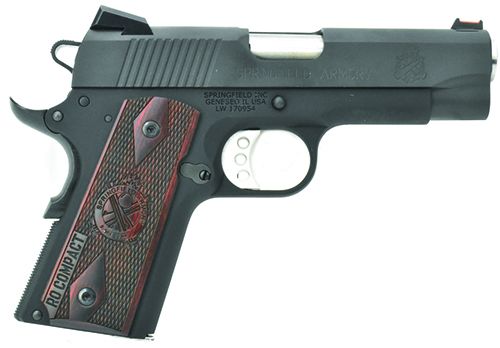
| Action Type | Semi auto, hammer fired, single action only |
| Overall Length | 7.6 in. |
| Overall Height | 5.1 in. |
| Maximum Width | 1.3 in. |
| Weight Unloaded | 27.8 oz. |
| Weight Loaded | 34.2 oz. w/9 rounds Hornady 124-gr. JHPs |
| Slide Material | Forged carbon steel |
| Slide Retraction Effort | 15.4 oz. |
| Receiver Material | Forged aluminum alloy |
| Finish | Parkerized |
| Front Strap Height | 2.25 in. |
| Back Strap Height | 2.75 in. |
| Barrel Length | 4.0 in. |
| Grip Thickness (Maximum) | 1.15 in. |
| Grip Circumference | 5.25 in. |
| Magazine | Two 8 round |
| Rear Sight | Novak 2-dot in dovetail with set screw, windage adjustable |
| Front Sight | Fiber-optic blade |
| Sight Radius | 5.5 in. |
| Trigger Pull Weight | 5.75 lbs. |
| Trigger Span | 2.5 in. |
| Safety | Firing pin drop, manual thumb safety, grip safety |
| Warranty | Limited lifetime for original owner |
| Telephone | (800) 680-6866 |
| Website | SpringfieldArmory.com |
| Made In | Brazil |
Besides Colt, the 1911 competition market has been well supported and well served by Springfield Armory. The company offers an array of 1911s running the gamut from absolute basic mil-spec to full-blown race guns, so we just had to have one of Springfield’s 9mms for our test. We chose the lightweight Range Officer Compact, which comes in a very desirable configuration. Namely, a 4-inch Commander-length slide mated to a shorter (think Colt Officer’s Model) frame. The result is a slightly muzzle heavy, yet very concealable pistol. The RO Compact has almost everything you could ask for. The alloy frame, steel slide, and all the controls except the trigger are a matte black. The trigger is brushed aluminum which, along with the polished barrel, make for nice contrasts to the black. The barrel is different in another way — it is a bull barrel (larger diameter) that uses a bushingless lockup. The barrel is built up at the muzzle and is fitted straight to the slide. It requires a reverse spring plug and a takedown pin, which is provided with the pistol. Movement of the barrel hood within the slide is virtually nil and speaks well for the craftsmanship in the pistol. The grip panels are slightly thinner than the normally slim 1911 grips and would project just that much less when concealed. The grip safety had the needed memory bump, though it wanted to release just a little bit later than we prefer. The mainspring housing is checkered, but the front strap is smooth. The magwell is properly beveled and was easy to reload into. The thumb safety was substantially larger than mil-spec but not large enough to be obnoxious. The required trigger compression was smooth and consistent. This pistol performed and shot well through all tests. We really liked the muzzle-heavy feel when we started doing the speed trials. The front sight is a very visible fiber optic, and the rear is a Novak style with two white dots. Both are set in dovetails. A replacement fiber-optic tube is included in the case along with the takedown pin. 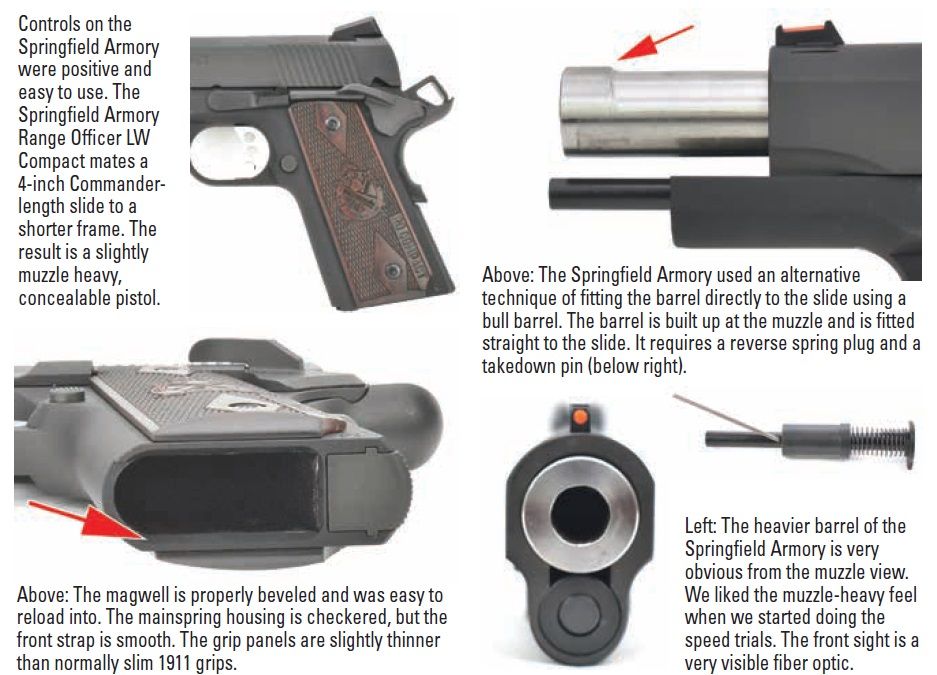 About the only problems we had came from the sights. Everything shot high and left. A couple of inches too high doesn’t concern us, but the RO Compact was shooting some ammo as much as 6 inches too high. And this was across the board, using several different brands and weights of ammunition. We weren’t having the same problems with other pistols that day, so it doesn’t appear to be just the testers. We think Springfield Armory should verify the height needed for this sight. We also remind our readers to test fire every firearm they purchase — especially for self-defense — and to ascertain the gun’s point of impact with whatever ammunition they choose.
About the only problems we had came from the sights. Everything shot high and left. A couple of inches too high doesn’t concern us, but the RO Compact was shooting some ammo as much as 6 inches too high. And this was across the board, using several different brands and weights of ammunition. We weren’t having the same problems with other pistols that day, so it doesn’t appear to be just the testers. We think Springfield Armory should verify the height needed for this sight. We also remind our readers to test fire every firearm they purchase — especially for self-defense — and to ascertain the gun’s point of impact with whatever ammunition they choose.
Our Team Said: The RO is a smooth-shooting pistol, full of features at a reasonable price. Our only knock was the front sight.
Ruger SR1911 LW Commander Stainless 06722 9mm Luger, $775
GUN TESTS GRADE: A (OUR PICK)
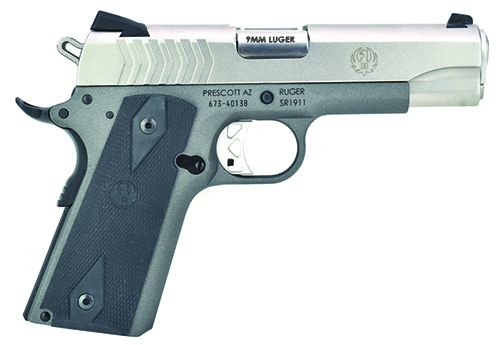
| Action Type | Semi auto, hammer fired, single action only |
| Overall Length | 7.9 in. |
| Overall Height | 5.4 in. |
| Maximum Width | 1.3 in. |
| Weight Unloaded | 27.0 oz. |
| Weight Loaded | 33.9 oz. w/10 rounds 124-gr. Hornady JHP |
| Slide Material | Stainless steel |
| Slide Retraction Effort | 15.2 oz. |
| Receiver Material | Anodized aluminum |
| Finish | Gun metal grey tone |
| Front Strap Height | 2.6 in. |
| Back Strap Height | 3.25 in. |
| Barrel Length | 4.25 in. |
| Grip Thickness (Maximum) | 1.2 in. |
| Grip Circumference | 5.25 in. |
| Magazine | Two 9 round |
| Rear Sight | Novak 2-dot in dovetail, drift adjustable, set screw |
| Front Sight | 1-dot blade in dovetail |
| Sight Radius | 5.8 in. |
| Trigger Pull Weight | 4.1 lbs. |
| Trigger Span | 2.5 in. |
| Safety | Firing pin drop, manual thumb safety, grip safety |
| Warranty | None provided |
| Telephone | (336) 949-5200 |
| Website | Ruger.com |
| Made In | USA |
Ruger introduced the SR 1911 in 2011 and has since added many calibers and variants to that product line. We wanted the Light Weight stainless-steel Commander version for our tests. It boasts a 4.25-inch fully ramped barrel in a stainless-steel slide mounted to a gray anodized-aluminum frame. Grip panels are black and rubberized. They, along with the matte-black controls, provide a nice three-tone look to the pistol. The thumb safety is oversized but has been rounded off so there are no sharp edges. The grip safety has a good memory bump and, more important, works when engaged then disengages easily. No death grip is required to shoot this pistol. Barrel lock up in the slide is rock solid. The bushing is pleasingly easy to rotate (we could disassemble the pistol without a bushing wrench) for what turned out to be a very accurate pistol. The mainspring housing is checkered and the front strap is smooth. The ejection port has been properly lowered and slightly relieved at the rear. The SR1911 also uses a “70 Series” firing-pin setup. This eschews the use of a firing pin safety (thus removing the requirement for more moving parts and a slightly heavier trigger), utilizing instead a titanium firing pin and a different firing-pin spring. Fewer moving parts and a better trigger pull while maintaining safety is a good thing. The barrel hood is notched at the rear, allowing a small view port to check for a loaded chamber. There are cocking serrations on the rear of the slide only. The magazine well has been properly beveled. The 3-dot sights are genuine Novak and set in drift-adjustable dovetails. 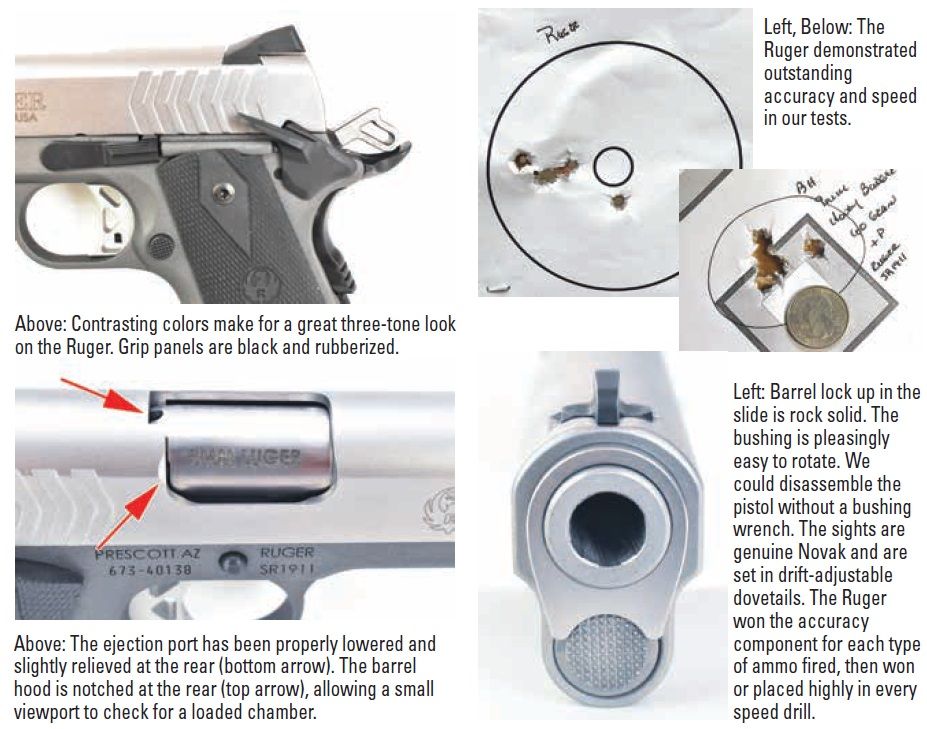 The current batch of polymer pistols bring many advantages over some of the old-style pistols. They can also bring their own issues. One of those can start with mainsprings. Many new-model pistols use a single spring to create pressure against the trigger and the striker. The 1911s employ a separate mainspring to power the hammer, a leaf spring to return the trigger and a third spring to return the slide to battery. This allows those with smaller hands or diminished grips to set those springs one at a time. The shooter can cock the hammer and then rack the slide, separately using less effort. The Ruger SR1911 uses an approach to springs opposite of that of the Taurus, in that the recoil spring is lighter than the others tested though it still functioned perfectly. This makes the slide easier to rack while also being a prime factor in making the Ruger feel like it had lighter recoil.
The current batch of polymer pistols bring many advantages over some of the old-style pistols. They can also bring their own issues. One of those can start with mainsprings. Many new-model pistols use a single spring to create pressure against the trigger and the striker. The 1911s employ a separate mainspring to power the hammer, a leaf spring to return the trigger and a third spring to return the slide to battery. This allows those with smaller hands or diminished grips to set those springs one at a time. The shooter can cock the hammer and then rack the slide, separately using less effort. The Ruger SR1911 uses an approach to springs opposite of that of the Taurus, in that the recoil spring is lighter than the others tested though it still functioned perfectly. This makes the slide easier to rack while also being a prime factor in making the Ruger feel like it had lighter recoil.
Our Team Said: The Ruger won the accuracy component for each type of ammo fired, then won or placed highly in every speed drill. It had the best trigger and the lightest perceived recoil in this test group. We were impressed.
Colt Lightweight Commander 9mm 04842XE 9mm Luger, $895
GUN TESTS GRADE: C
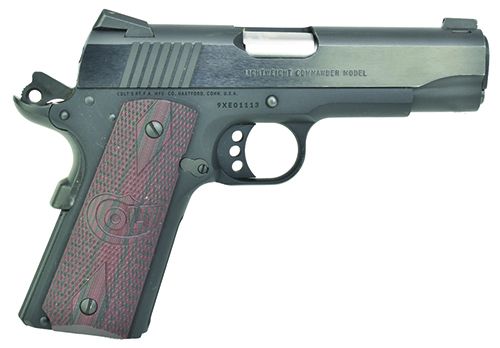
| Action Type | Semi auto, hammer fired, single action only |
| Overall Length | 7.75 in. |
| Overall Height | 5.4 in. |
| Maximum Width | 1.4 in. including thumb safety |
| Weight Unloaded | 27.7 oz. |
| Weight Loaded | 34.7 oz. w/10 rounds 124-gr. Hornady JHP |
| Slide Material | Blued carbon steel |
| Slide Retraction Effort | 15.1 oz. |
| Receiver Material | Aluminum alloy |
| Finish | Blued |
| Front Strap Height | 2.75 in. |
| Back Strap Height | 3.25 in. |
| Barrel Length | 4.25 in. |
| Grip Thickness (Maximum) | 1.25 in. |
| Grip Circumference | 5.25 in. |
| Magazine | Two 9-round |
| Rear Sight | Novak 2-dot in dovetail, windage adjustable |
| Front Sight | 1-dot blade |
| Sight Radius | 5.6 in. |
| Trigger Pull Weight | 4.75 lbs. |
| Trigger Span | 2.5 in. |
| Safety | Firing pin drop, manual thumb safety, grip safety |
| Warranty | Limited lifetime |
| Telephone | (800) 962-2652 |
| Website | Colt.com |
| Made In | USA |
The Colt 1911 pistol has a very storied past and the history on this particular model is no different. In 1951 various solutions were proposed when the Army requested a replacement for the 1911 chambered in 45 ACP. Since all NATO members were using 9mm for their pistols, our military wanted to comply as well. Requirements also included limiting length to no more than 7 inches and weight to no more than 25 ounces. Accordingly, Colt submitted a 1911 pistol chambered in 9mm with a 4.25-inch barrel and an aluminum frame. Eventually, the Army decided to stick with the small arms they had, but Colt thought they had a winner on their hands and introduced the new pistol to the public. Colt introduced the all-steel commander in 1970, requiring a difference in nomenclature. The all-steel version has since been known as the “Combat Commander” and the aluminum-framed version became the “Lightweight Commander.” Both have indeed been major successes for Colt over the years. We have documented upgrades being made to many 1911s over the course of this article. Our Colt LW Commander also sports the better sights, beavertail with memory bump, rounded hammer, better trigger, better thumb safety, etc. Our sample has the flat mainspring housing with vertical serrations, as does the frontstrap. The magazine well has the least improvement on it of any we tested here, showing just a light bevel on some of the well. We felt the pistol balanced the best of the four pistols tested. The trigger was excellent and the sights more than sufficient. While not the highly polished slides of 50 years ago, the flats of the slides were smooth and the lines were sharp, with no visible tool marks on the pistol. Colt has learned a few things about making this pistol. Except three things that really disappointed us. First was the barrel. One of the tests for potential accuracy in a 1911 is to push down on the hood of the barrel. Movement is a bad thing. It means the barrel has not been fitted all that tightly to the slide and frame. The hood on our sample moves a good bit. The barrel and its setup were causes of additional concern. Most modern 1911 barrels are ramped and polished all along the lower radius of the barrel mouth. This aids in feeding ammunition other than standard full metal jacket. The Colt 1911 was not polished at all and showed a very narrow ramp, which proved problematic in some of the ammunition we used for testing. This pistol almost refused to feed Black Hills Honey Badger ammo, which has worked fine in every other pistol tested. A ramp and throat job, which widens and polishes the feed ramp, can easily be done by a competent gunsmith. Do not try it with your Dremel tool. The angles and surfaces are critical in proper feeding. 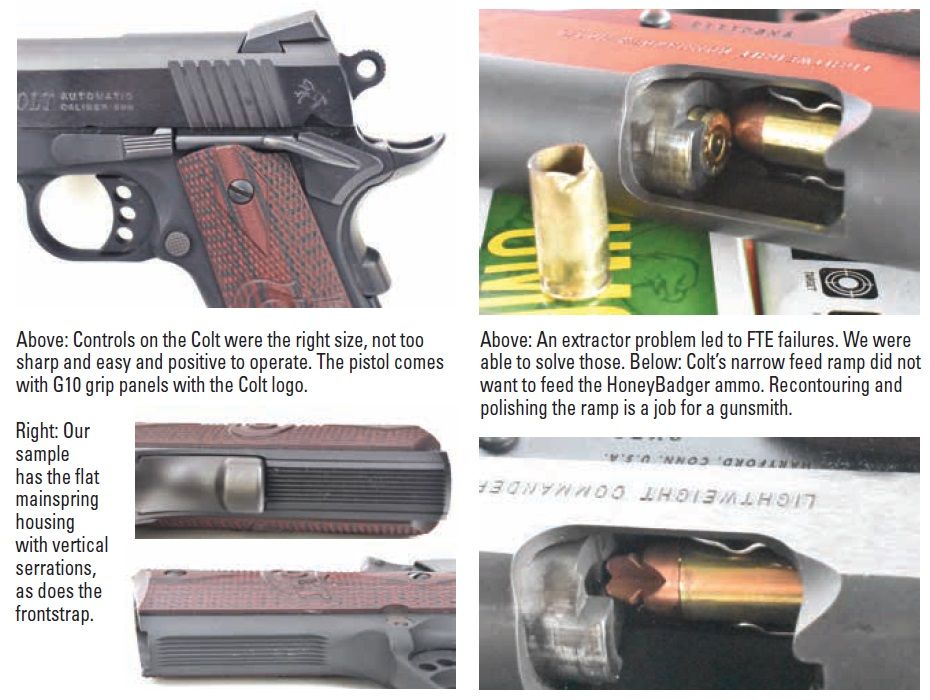 Next, problems may develop (note we said may, not will) on alloy-framed semi-automatic pistols where the feed ramp to the barrel is also alloy. The metal in the bullets can be harder than the alloy ramp and may damage the ramp over time. Many manufacturers have solved this problem via a simple solution: use a barrel with a steel feed ramp that is part of the barrel and then mill the frame to allow the differently shaped barrel to sit where it needs to go. Then every bullet being pushed forward out of the magazine impacts into the steel ramp instead of a softer alloy ramp. The other two alloy pistols in this test (Ruger and Springfield) use this system. Even the steel-framed Taurus uses this system. The Colt does not. Last is the extractor. This is the hook that pulls a cartridge (loaded or fired) from the chamber, back into the ejector (projection on the other side of the frame), which then pushes the cartridge or case out of the ejection port. Signs of an improperly tuned extractor include empty cases being left in the chamber after firing. While the other three pistols worked flawlessly, our Colt started leaving empties in the chamber, causing a double-feed. This virtually new pistol belonged to a somewhat chagrined member of our test team, so we felt a bit freer to experiment with his gun. We checked the extractor only to find that we could wiggle the extractor hook as it protrudes from the breech face. That is a bad sign. We removed the extractor and put some tension on it then reinstalled. It worked perfectly from that point on.
Next, problems may develop (note we said may, not will) on alloy-framed semi-automatic pistols where the feed ramp to the barrel is also alloy. The metal in the bullets can be harder than the alloy ramp and may damage the ramp over time. Many manufacturers have solved this problem via a simple solution: use a barrel with a steel feed ramp that is part of the barrel and then mill the frame to allow the differently shaped barrel to sit where it needs to go. Then every bullet being pushed forward out of the magazine impacts into the steel ramp instead of a softer alloy ramp. The other two alloy pistols in this test (Ruger and Springfield) use this system. Even the steel-framed Taurus uses this system. The Colt does not. Last is the extractor. This is the hook that pulls a cartridge (loaded or fired) from the chamber, back into the ejector (projection on the other side of the frame), which then pushes the cartridge or case out of the ejection port. Signs of an improperly tuned extractor include empty cases being left in the chamber after firing. While the other three pistols worked flawlessly, our Colt started leaving empties in the chamber, causing a double-feed. This virtually new pistol belonged to a somewhat chagrined member of our test team, so we felt a bit freer to experiment with his gun. We checked the extractor only to find that we could wiggle the extractor hook as it protrudes from the breech face. That is a bad sign. We removed the extractor and put some tension on it then reinstalled. It worked perfectly from that point on.
Our Team Said: We got average accuracy from this pistol, we think, because of the somewhat poorly fitted barrel. We worry about the long-time viability for a heavily used 1911 with a non-ramped frame. We fixed the extractor quickly. We feel that we should not have had to. Colt makes an outstanding firearm. They have also had 70 years to work the kinks out of this one. The other three firearms we tested in this group already employ the new production methods eliminating the three problems. We are disappointed Colt has not yet decided to do so. Finally, we must ask whether we blaspheme by the mere suggestion that one of JMB’s most incredible creations could function properly while chambered in a “minor” caliber. We think we are still pious. Will a 9mm ever equal a 45 ACP shot to shot? No. But the energy figures for a fast 9mm come very close to some of those big, slow 45s. Sometimes they exceed them. And how could having a greater number of an effective, less expensive, lighter-recoiling cartridge in the outstanding 1911 platform be a bad idea? If it were us, we’d buy a Ruger Light Weight Commander and see if we liked it for self- or home-defense.
Written and photographed by Joe Woolley, using evaluations from Gun Tests team testers.


























